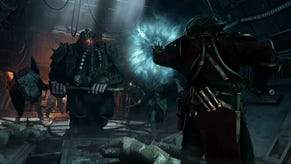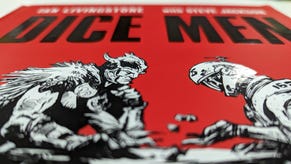Warhammer 40,000: Darktide's gunplay is deliciously meaty
How Fatshark finessed a "really tricky" twist on the shooter.
It feels real good to shoot stuff in Warhammer 40,000: Darktide. This might not sound like the biggest deal - it's always important for this type of horde-based, zombie-mowing game - but for Darktide good shooting is significant. Developer Fatshark, who previously made spiritual, franchise-adjacent predecessors Warhammer: Vermintide and Vermintide 2, hadn't used actual FPS mechanics before, with Vermintide almost entirely based on melee. And doing it right in Darktide, it turns out, has been a challenge.
"It's been tricky," says Mats Andersson, lead combat designer at Fatshark, who was speaking to us at Gamescom. He explains it's something they had to build up to step-by-step, in part because of the game's hybrid approach that mixes both melee and first-person shooting. "We knew that we wanted to do a hybrid kind of thing," he said, "as we wanted to keep the melee part, because we wanted to extend it, rather than have a completely separate game mode with ranged combat."
Originally Darktide had what Andersson called "simple ADS," where holding aim will simply bring a ranged weapon up to the middle of the screen to give you that "aim down sights" perspective, like it would in most FPS games. But Andersson described the result, "if you just have a static animation with some spread on it," as "less than stellar." The big push, therefore, has been to "up the quality of that, and doing some more finicky and sophisticated things with recoil and spread, the swaying animation blend sets, lining everything up so it's so controlled that the gun lines up and shoots where it needs to shoot."
This sounds technical and, as Andersson put it, finicky, but he provided a good example. "With the lasguns," the laser-based weapons used by some of Darktide's Imperial Guard characters, "since we have beams, we can't point the gun in one direction and shoot in another. It looks horrible. So we've made this overcomplicated thing of actually having all of those motions you see - they aren't really animations, they're code-driven, so the gun always kind of sways the way the next shot is going to go." This also plays into another aspect of realism, where you might get hit while aiming, and the aiming animation shows that, but also still lines up with where you're shooting off in a different direction - "but it's really tricky, and it creates an even deeper mastery of it."
On the other hand, he says, the whole challenge has been "getting this extended range thing up and running, because Vermintide had melee, and most ranged games for FPS have a far range - we have a melee, a far range and then a close range in between. So there's basically three different "gameplays" involved in that, and there becomes this meta loop of the team and the enemies fighting over: at what range should we be fighting?"

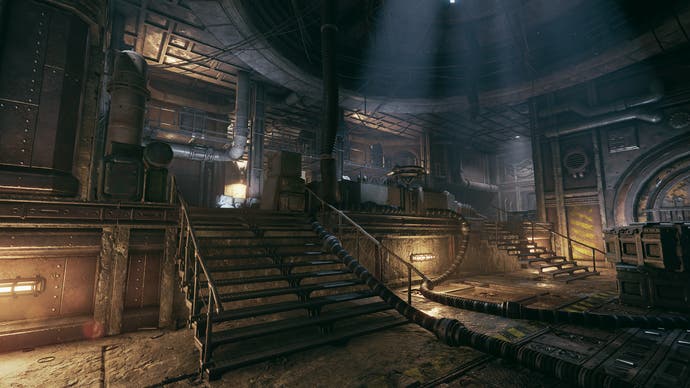
This plays into another, more sophisticated part of Darktide's gunplay: the enemies that spawn will adapt to how you're dealing with them. "They switch behaviour depending on what range you kind of force on them," Andersson explains. "Like if the enemies have loads of machine guns you kind of want the Zealot to jump them," the Zealot being a melee character with a whacking great hammer, "because then they start shooting and you're forced into melee."
"As we saw with the Psycher here," he continues, talking about the gameplay session we'd just finished, "if he's like, "I want to stand here and pop heads," then we send in some pox walkers and like, nya! And then he can't do that anymore."
Andersson has more to say on this - he gives another example of a longer-ranged enemy that will stay in cover and almost protect a kind of defensive sight-line, forcing you to "at best pot-shot them, or you can suppress them and throw a grenade in there, or flank and jump them in melee, if you want." Closer range shooting is more "twitchy classic old school FPS," that's "more of the Doom-like, side-strafe, dodge, shoot five guys with a shotgun in a short amount of time, and then leaning over into the melee, because sooner or later your clip is gonna run dry, and you have a chainsword so you might as well use it."
The takeaway is that there is a wonderful amount of thought to the rhythm and strategy of Darktide's combat, more than I could, admittedly, get into with my demo. That featured one, nicely lengthy mission through the bowels of this decidedly menacing megacity, called Tertium. Playing as an Ogryn with a semi-automatic shotgun (that switches to automatic if you like), my job was to tank damage and dish it out rapidly in close-range combat against squishier hordes. It is supremely satisfying.
.png?width=690&quality=75&format=jpg&auto=webp)
.png?width=690&quality=75&format=jpg&auto=webp)
In this demo, mind, it was just about finding enough ammo, which felt very constricted on this medium-tier difficulty without being cruel, to keep the wave-clearing going. In more coordinated groups (no disrespect to my randomly-assigned teammates, who may or may not have left the wave-clearing tank character to solve all the keypad puzzles in an area while they chipped away at the rushing hordes, and then go round rescuing them all after the fact), I can immediately see how combat will get more nuanced.
.jpg?width=690&quality=75&format=jpg&auto=webp)
That said, the choice is also part of the design. Andersson and Darktide game director Anders de Geer explained that there's a good deal of customisation to how you might set up a game. Difficulty levels will impact the strength and intelligence of enemies, but you can also adjust the numbers, it seems, so you might want a stealthy, high difficulty round against a small number of enemies or a lower-difficulty one against waves and waves of squelching zombies. This also plays into your choice of class - if you like, you can squad up as four Ogryns, but you might struggle when a sniper turns up on the other side of the map, or as four Psykers who can pop heads of mini-bosses with ease but might flounder against the horde.
De Geer also emphasises that, as well as dealing with the novel issue of a varied, and quite ambitious take on gunplay, there were a few reasons for Darktide's slight delay to late November on PC (console versions are coming "soon" after that). "It's going good," he says, when I ask about development in general, "I think, like everyone would say, of course lockdowns and stuff have been worse than we thought, we thought we were in a pretty good place, but now coming back to the office and-" Andersson interjects, "-and finding out what everyone's been building," timeframes had to adapt somewhat. "But then also," De Geer says, "we have re-written a lot of technology, so it's a lot of that, fine tuning stuff, making sure that everything works."
"I mean [delaying] launch to me is down to what Fatshark does," Andersson adds, "we're trying to be honest with what actually works, and trying to find the problems. It would be different if we did a 'copy/paste' game. In this case, we're trying to move to another kind of setting and expanding on the ranged stuff and tuning up everything."


The emphasis is that the game has had to change a fair bit over time. "It's really hard to predict exactly when you want to say it's enough, unless you just do what you said you were going to do, and then accept whatever quality it is - and that's not, really, what we do. Currently it's kind of nice, because we're getting into that [stage where] everything is kind of working. The game plays nice. And it's fun."
"The first time we talked about the project," De Geer says, "it's pretty similar to where we are today. But then, there have been a lot of different things not work. We definitely didn't think we needed to go this far with ranged combat. We thought we would get there faster. But then we realised, it's not only the FPS experience, it's also the enemies, and we also need to do huge behaviour fixes for them, for us to actually be able to play with melee and ranged."
Andersson gives a final example of the chainsword, which has taken a "full loop" from being "sticky," where it gets stuck in enemies you attack and follows them, to that feeling "weird," to it now being something you can activate and being "sticky, a bit," but then "you can revv it even further, like this - there's a lot of things where the original vision has held true, but the method and the details and implementation have gone through a lot.
"It kind of ties into that "when are we done?" question," he says. "Well, we're done when it's good."
.png?width=690&quality=75&format=jpg&auto=webp)



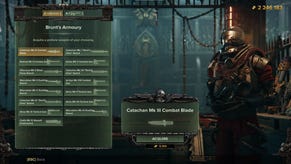
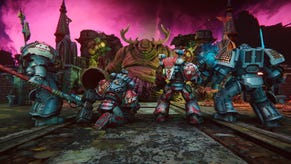
.jpg?width=291&height=164&fit=crop&quality=80&format=jpg&auto=webp)
